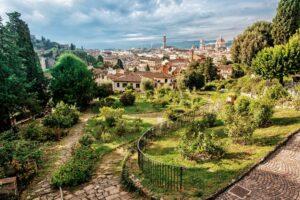Fodor's Expert Review Battistero
The octagonal Baptistery is one of the supreme monuments of the Italian Romanesque style and one of Florence's oldest structures. Local legend has it that it was once a Roman temple dedicated to Mars (it wasn't), and modern excavations suggest that its foundations date from the 1st century AD. The round Romanesque arches on the exterior date from the 11th century, and the interior dome mosaics from the beginning of the mid-13th century are justly renowned, but—glittering beauties though they are—they could never outshine the building's famed bronze Renaissance doors decorated with panels crafted by Lorenzo Ghiberti. Copies of the doors on which Ghiberti worked (1403–52) most of his adult life are on the north and east sides of the Baptistery (to protect them from pollution and acid rain, the original doors were moved to the Museo dell'Opera del Duomo, where they're now on display). The Gothic panels on the south door were designed by Andrea Pisano (circa 1290–1348) in 1330.
Ghiberti's... READ MORE
The octagonal Baptistery is one of the supreme monuments of the Italian Romanesque style and one of Florence's oldest structures. Local legend has it that it was once a Roman temple dedicated to Mars (it wasn't), and modern excavations suggest that its foundations date from the 1st century AD. The round Romanesque arches on the exterior date from the 11th century, and the interior dome mosaics from the beginning of the mid-13th century are justly renowned, but—glittering beauties though they are—they could never outshine the building's famed bronze Renaissance doors decorated with panels crafted by Lorenzo Ghiberti. Copies of the doors on which Ghiberti worked (1403–52) most of his adult life are on the north and east sides of the Baptistery (to protect them from pollution and acid rain, the original doors were moved to the Museo dell'Opera del Duomo, where they're now on display). The Gothic panels on the south door were designed by Andrea Pisano (circa 1290–1348) in 1330.
Ghiberti's north doors depict scenes from the life of Christ; his later east doors (1425–52), facing the Duomo facade, render scenes from the Old Testament. Both merit close examination, for they are very different in style and illustrate the artistic changes that marked the beginning of the Renaissance. Look at the far right panel of the middle row on the earlier (1403–24) north doors (Jesus Calming the Waters). Here, Ghiberti captured the chaos of a storm at sea with great skill and economy. The artistic conventions he used, however, are basically pre-Renaissance: Jesus is the most important figure, so he is the largest; the disciples are next in size, being next in importance; the ship on which they founder looks like a mere toy.
The exquisitely rendered panels on the east doors are larger, more expansive, more sweeping—and more convincing. The middle panel on the left-hand door tells the story of Jacob and Esau, and the various episodes of the story—the selling of the birthright, Isaac ordering Esau to go hunting, the blessing of Jacob, and so forth—have been merged into a single beautifully realized street scene. Ghiberti's use of perspective suggests depth: the background architecture looks credible, the figures in the foreground are grouped realistically, and the naturalism and grace of the poses (look at Esau's left leg and the dog next to him) have nothing to do with the sacred message being conveyed. Although the religious content remains, the figures and their place in the natural world are given new prominence and are portrayed with a realism not seen in art since the fall of the Roman Empire nearly a thousand years before.
As a footnote to Ghiberti's panels, one small detail of the east doors is worth a special look. To the lower left of the Jacob and Esau panel, Ghiberti placed a tiny self-portrait bust. From either side, the portrait is extremely appealing—Ghiberti looks like everyone's favorite uncle—but the bust is carefully placed so that you can make direct eye contact with the tiny head from a single spot. When that contact is made, the impression of intelligent life—of modern intelligent life—is astonishing. It's no wonder that these doors received one of the most famous compliments in the history of art from an artist known to be notoriously stingy with praise: Michelangelo declared them so beautiful that they could serve as the Gates of Paradise.
READ LESS







